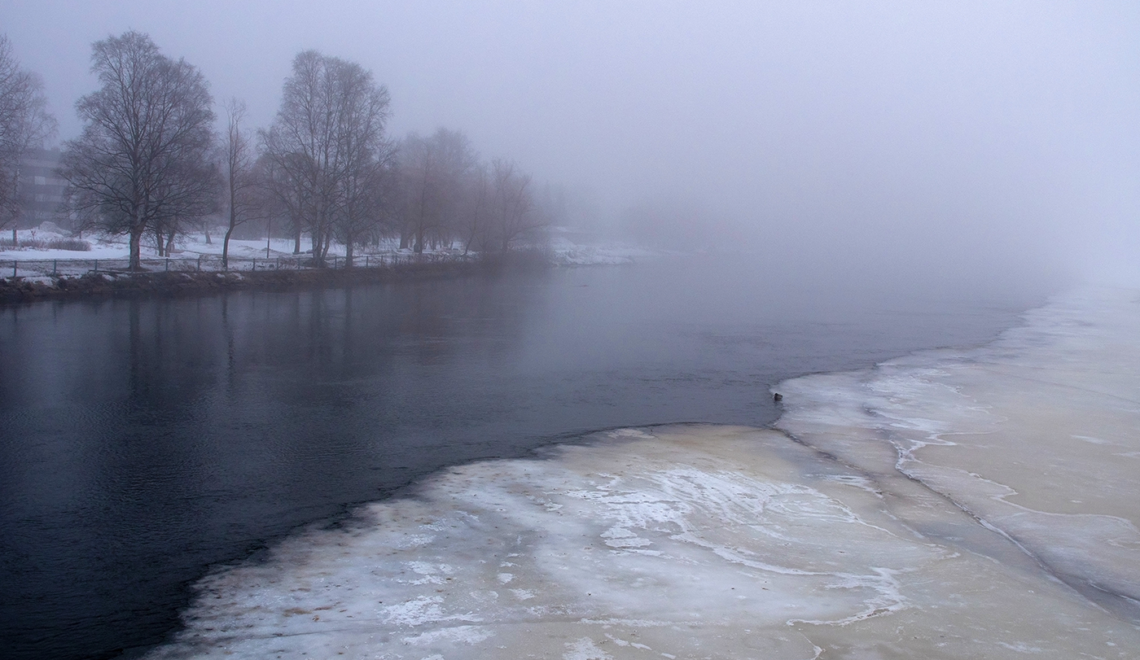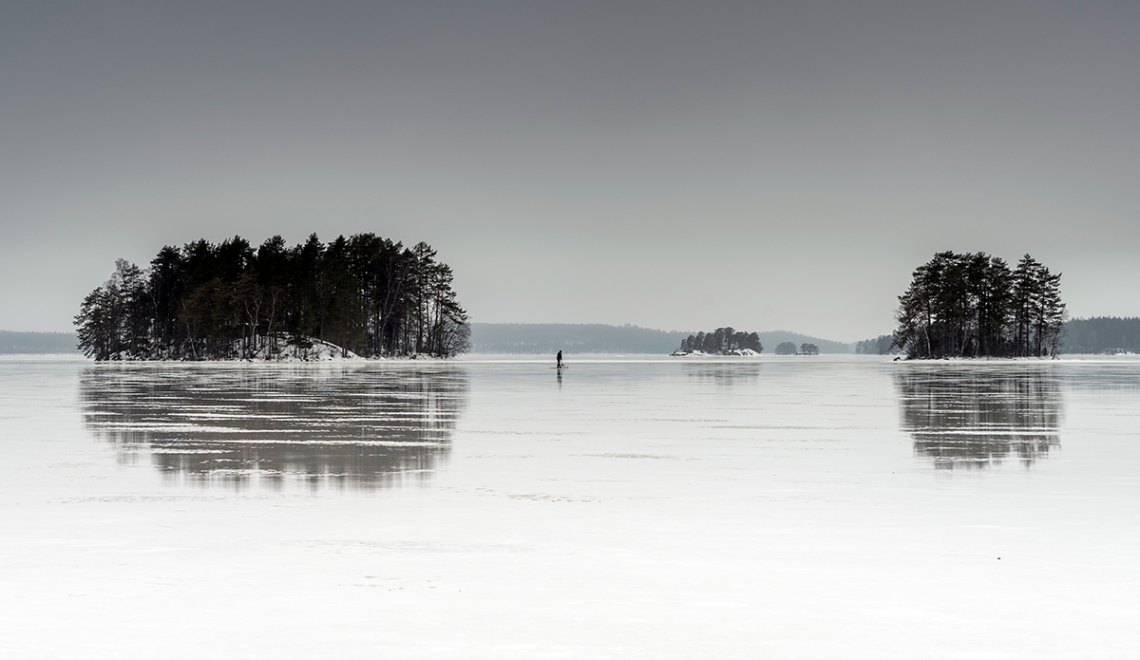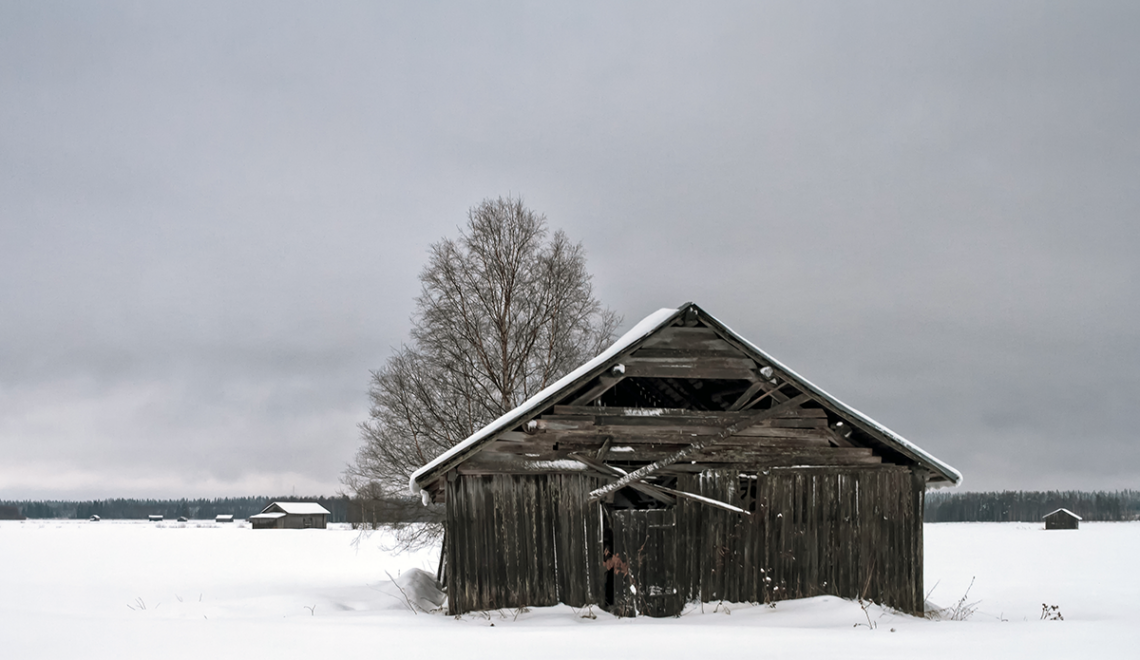The winter of 2019/2020 saw unprecedented mild weather in most of Finland. The winter was moreover characterized by exceptionally thick snow cover in Lapland. At the same time, there was hardly any snow in southern Finland.
ILARI LEHTONEN
Finnish Meteorological Institute
In Europe, the large-scale atmospheric circulation pattern during the winter of 2019/2020 was characterized by anomalously strong westerlies due to a low-pressure anomaly centred over the Norwegian Sea and northern Scandinavia and a high-pressure anomaly over the Mediterranean Basin (Fig. 1). Persistent westerlies thus pushed mild maritime air from the Atlantic to Northern Europe and all the way to Siberia in the east. In north-western Russia and southern Finland, the mean December to February temperature was over large areas approximately 6–7 °C above the long-term average.
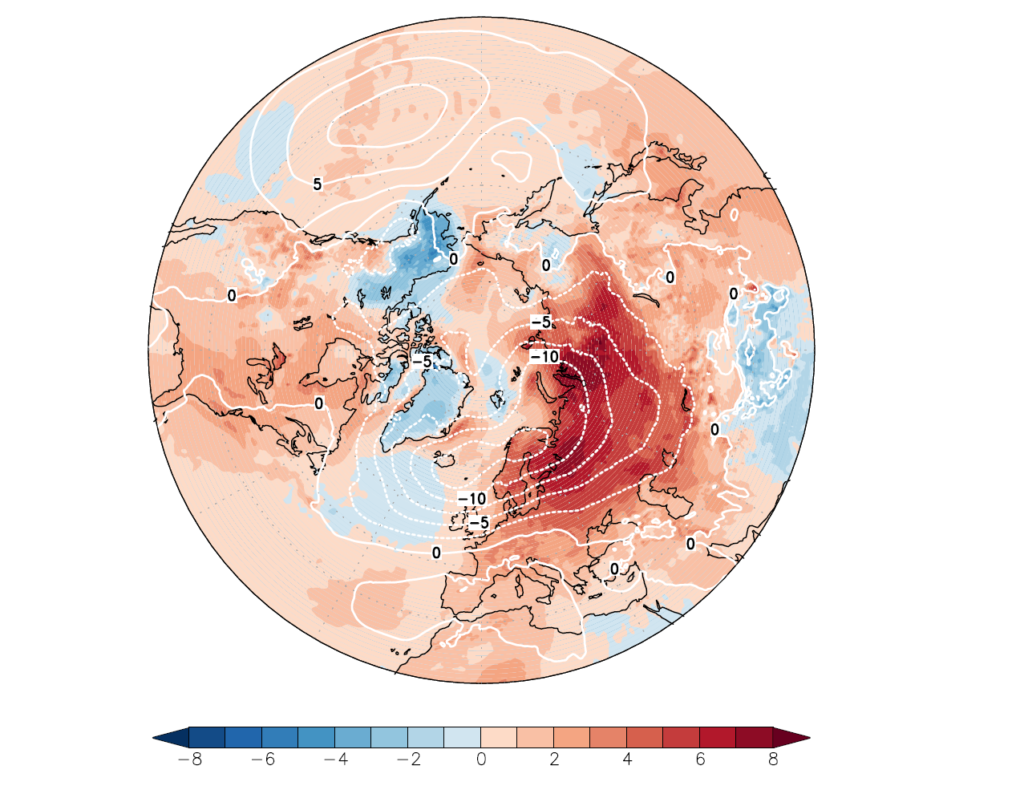
In Finland, it was the mildest winter on record in the southern and central parts of the country. Temperatures in Lapland were closer to the typical values, but even there the mean temperature was 2–5 °C above the long-term average. The estimated country average for the mean December to February temperature surpassed the previous records from the winters of 1924/1925 and 2007/2008 by 0.3 °C (Fig. 2a).
In Fig. 2, further temperature and snow-related winter weather statistics from two weather stations, one in the south (Kaisaniemi, Helsinki at the Finnish southern coast) and one in the north (Tähtelä, Sodankylä in central Lapland), are illustrated for the past 120 years. In Helsinki, like elsewhere in the southern parts of Finland, 2019/2020 was the mildest winter on record. The mean temperature of the winter in Helsinki was 2.3 °C, surpassing the previous record from the winter of 2007/2008 by 0.9 °C. In Sodankylä, the mean temperature was -8.0 °C making 2019/2020 the seventh mildest winter on record, and 0.6 °C warmer than the record mild winter of 2007/2008.
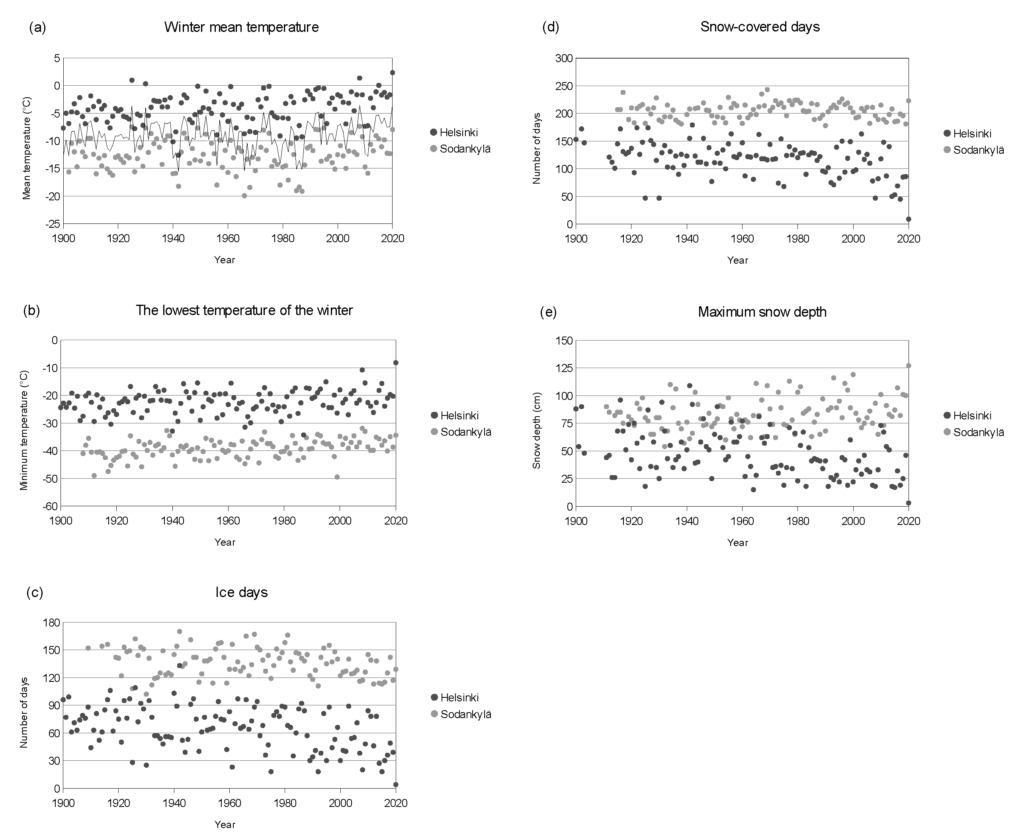
FIG 2: Winter weather statistics for Helsinki in southern Finland and for Sodankylä in northern Finland for the winters from 1899/1900 to 2019/2100. (a) December to February mean temperature, (b) the lowest temperature during the winter, (c) number of ice days with daily maximum temperature below 0 °C during the winter, (d) number of snow-covered days during the winter, and (e) the maximum snow depth during the winter. For mean temperature, also the country average according to Tietäväinen et al. (2010) and Aalto et al. (2016) is shown. On the x-axis, e.g., the label 1900 refers to the winter of 1899/1900.
One striking feature of the winter weather was a complete lack of even short cold periods in southern Finland. In Helsinki, the lowest temperature during the whole winter was as high as -8.2 °C measured on 29 February (Fig. 2b). It was the second winter on record when temperature did not drop even once below -15 °C in the Finnish capital. In the north, there were some relatively cold, though short, periods as well. However, an increasing long-term trend can be seen in the winter minimum temperatures in Sodankylä as the lowest temperature of the winter has rarely dropped below -40 °C after the winter of 1998/1999 when the record cold temperature of -49.5 °C was measured.
The lack of cold periods in southern Finland during the winter of 2019/2020 is evident from the low numbers of ice days, i.e., days with the maximum temperature below freezing (Fig. 2c), and snow-covered days (Fig. 2d). In Helsinki, there were only four ice days while the smallest number of ice days during a winter had previously been 18. Snow cover could only be measured in Helsinki on nine days, while the previous record for the smallest number of snow-covered days was 45. January, February and March were completely snow free, although it must be noted that automized weather stations have difficulties in measuring very shallow snow cover. Hence, the observations from the recent years are not completely comparable to earlier manual observations. Nevertheless, the highest snow depth in Helsinki during the winter of 2019/2020 was only 3 cm, measured as late as on 16 April, while previously snow depth had reached at least 15 cm in each winter.
In Sodankylä in northern Finland, snow statistics were also record-breaking during the winter of 2019/2020. However, this was not due to a lack of snow but because of an excess of snow. The peak snow depth in Sodankylä was 127 cm, measured on 15 April, and it was the highest snow depth on record at the station. An even higher snow depth of 138 cm was measured in Saariselkä, Inari on 18 April. Although these were new snow depth records in this part of the country, even higher snow depths have been previously measured elsewhere in Finland, most often in the very northwesternmost edge of Lapland, where also the national snow depth record, 190 cm, was measured in the village of Kilpisjärvi on 19 April 1997 (Table 1). In other parts of Finland, higher snow depths than those measured in Central Lapland during the winter of 2019/2020 were measured last time in Kainuu in early March 2000. Historically, the most renowned snowy winter in Finland has been the winter of 1898/1899 when snow depth reached in March approximately 150 cm in the regions of Northern Savonia and North Karelia (Alfthan, 1911). Also in March 1900, there were approximately 140 cm of snow as south as locally in Uusimaa (Kersalo and Pirinen, 2009). During the winter of 2019/2020, snow cover also persisted much longer than is typical for northern Finland, although the count of snow-covered days in Sodankylä, 223 days, was not a new record. It was still the highest count of snow-covered days there since the winter of 1995/1996.
| Station | Administrative region | Date | Snow depth |
|---|---|---|---|
| Kilpisjärvi, Enontekiö | Lapland | 19 April 1997 | 190 cm |
| Kilpisjärvi, Enontekiö | Lapland | 19 January 1992 | 176 cm |
| Kilpisjärvi, Enontekiö | Lapland | 14 March 1993 | 170 cm |
| Maanselkä Kurkijärvi, Kuusamo | Northern Ostrobothnia | 23 April 1993 | 168 cm |
| Kilpisjärvi, Enontekiö | Lapland | 31 March 1991 | 159 cm |
| Kilpisjärvi, Enontekiö | Lapland | 5 April 2014 | 158 cm |
| Kilpisjärvi, Enontekiö | Lapland | 24 February 1964 | 155 cm |
| Riuttaskylä, Kuru | Pirkanmaa | 12 February 1984 | 155 cm |
| Pokka, Kittilä | Lapland | 16 April 1997 | 155 cm |
| Haapovaara, Suomussalmi | Kainuu | 5 March 2000 | 151 cm |
| Kilpisjärvi, Enontekiö | Lapland | 14 March 1963 | 150 cm |
| Pokka, Kittilä | Lapland | 22 February 1974 | 148 cm |
| Kursu, Salla | Lapland | 5 March 2000 | 147 cm |
| Kilpisjärvi, Enontekiö | Lapland | 30 March 1989 | 146 cm |
| Pokka, Kittilä | Lapland | 16 March 1998 | 145 cm |
| Pisavaara, Rovaniemen maalaiskunta | Lapland | 4 April 1965 | 143 cm |
| Kilpisjärvi, Enontekiö | Lapland | 27 March 2017 | 143 cm |
| Näkkälä, Enontekiö | Lapland | 29 March 1967 | 142 cm |
| Ylimaa, Ranua | Lapland | 6 April 1969 | 142 cm |
| Suomussalmi kk | Kainuu | 22 March 1962 | 140 cm |
| Pallasjärvi, Kittilä | Lapland | 28 March 1967 | 140 cm |
| Näljänkä, Suomussalmi | Kainuu | 5 March 2000 | 140 cm |
Due to global warming, equally mild winters as 2019/2020 are expected to become more frequent in the future. According to high-emission scenarios under the Representative Concentration Pathway (RCP) 8.5, the winter mean temperature could most likely rise by approximately 4 °C by circa 2050 relative to 1981–2010 and by even 8 °C by 2100 (Ruosteenoja et al., 2016). These scenarios could occur when the global mean temperature increases by approximately 4 °C during the current century. If the rate of global warming could be slowed down, the warming of the Finnish winters would remain smaller too. For example, under the RCP4.5, the global mean temperature would rise most likely almost by 2 °C during the 21st century and the Finnish winters would become by about 4–5 °C warmer at the same time. Moreover, as most climate models show a cold bias over Northern Europe and the models with most severe cold bias tend to indicate the most intense warming, the models on average might somewhat overestimate the warming in Finland in winter (Räisänen and Ylhäisi, 2015).
Acknowledgements: Copernicus Climate Change Service is acknowledged for making the ERA5 reanalysis data available at https://doi.org/10.24381/cds.adbb2d47.
References:
Aalto, J., et al., 2016: New gridded daily climatology of Finland: Permutation-based uncertainty estimates and temporal trends in climate. J. Geophys. Res. Atmos., 121, 3807–3823.
Alfthan, M., 1911: Suomen kartasto 1910. Suomen Maantieteellinen Seura, Helsinki.
Hersbach, H., et al., 2020: The ERA5 global reanalysis. Quart. J. Roy. Meteorol. Soc., 146, 1999–2049.
Kersalo, J., and Pirinen, P., 2009: Suomen maakuntien ilmasto. Finnish Meteorological Institute Reports 2009:8, Helsinki.
Räisänen, J., and Ylhäisi, J. S., 2015: CO2-induced climate change in northern Europe: CMIP2 versus CMIP3 versus CMIP5. Clim. Dynam., 45, 1877–1897.
Ruosteenoja, K., et al., 2016: Climate projections for Finland under the RCP forcing scenarios. Geophysica, 51, 17–50.
Tietäväinen, H., et al., 2010: Annual and seasonal mean temperatures in Finland during the last 160 years based on gridded temperature data. Int. J. Climatol., 30, 2247–2256.
HOW TO CITE THIS ARTICLE:
Lehtonen I., 2021: Record mild winter of 2019/2020 in most of Finland, FMI’s Climate Bulletin: Research Letters, 3(1), 4–7, DOI: https://doi.org/10.35614/ISSN-2341-6408-IK-2021-02-RL
CITATION INFORMATION:
Authors: Ilari Lehtonen
Received: September 18, 2020
Accepted: June 9, 2021
First online: June 22, 2021
Published: June 24, 2021
Corrected: August 2, 2021
Journal: FMI’s Climate Bulletin: Research Letters
Volume: 3
Issue: 1
Pages: 4–7
DOI: https://doi.org/10.35614/ISSN-2341-6408-IK-2021-02-RL
Header image: Joona Kotilainen/kuviasuomesta.fi

